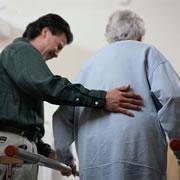 Our own tissues may have the power to recover from stroke - if we can harness it.© Getty
Our own tissues may have the power to recover from stroke - if we can harness it.© GettyStimulating a protein on the surface of the brain's stem cells helps rats recover after a stroke, US researchers have found. The discovery suggests that in humans it could be possible to provoke the body's own stem cells into repairing an injury, rather than laboriously growing and transplanting new cells.
Researchers believe that many of the body's tissues harbour stem cells capable of dividing to make new tissue. But some of these are recalcitrant and do not naturally divide to repair damage wreaked by severe injuries such as stroke or spinal-cord damage.
Ronald McKay and his colleagues at the National Institute of Neurological Disorders and Stroke in Bethesda, Maryland, have now shown that one protein, called Notch, can boost the survival of three different types of stem cell1. Notch sits on cell surfaces and is vital for the correct growth of embryos.
Raising it a Notch
“You can think of stem cells as being in a balance between these two pathways.”
Ronald McKay
National Institute of Neurological Disorders and Stroke, Bethesda, Maryland
The team studied rats afflicted with a stroke-like brain injury that normally dulls their movement. When they infused the animals' brains for one week with a molecule that stimulates Notch, the animals' movements improved. The rats also sprouted a collection of new cells in the brain.
The researchers do not yet know whether this could be used to treat humans after a stroke, because stimulating Notch could have many other, perhaps unwanted, effects in the brain. But it does suggest that drugs that provoke Notch or a related protein might one day be used to persuade stem cells in the brain or other tissues to do what doctors want.
Harnessing the body's own stem cells could offer an enticing alternative to attempts to harvest them from other sources, such as embryos. "This is where stem-cell biology needs to be," says McKay.
Attention to detail
Many researchers are seeking chemicals or proteins that can coax stem cells into multiplying or generating particular cell types. But even when they are successful, the details are often unclear: exactly how does a particular protein, sprinkled on to the outside of a cell, end up causing changes inside?
McKay's team tried to figure this out for Notch. The team found that rousing Notch stops stem cells from dying within minutes. This rapid effect suggests that Notch has knock-on effects on signals being transmitted within the cell.
Indeed, the team uncovered two chains of molecules triggered by Notch that have opposing effects on the cell and are fundamental in controlling growth of cancer cells.
One promotes cell survival and division. A second seems to nudge stem cells into becoming other cell types instead. "You can think of stem cells as being in a balance between these two pathways," McKay says.
ADVERTISEMENT
The team showed that triggering the survival pathway helps both human embryonic stem cells and cells from the developing mouse pancreas survive in a dish. This suggests that this same mechanism could be common in many, or even most, stem cells.
The results also support the idea that cancer, in which cells divide uncontrollably, hijacks mechanisms normally used to schedule the orderly division of stem cells.
Tinkering with Notch could run the risk of triggering cancer. But tweaking other parts of the cellular machinery might have effects only in the brain, says Fernando Camargo, who studies blood stem cells and cancer at the Whitehead Institute in Cambridge, Massachusetts.
Visit our canbemadeto_selfrepai.html">newsblog to read and post comments about this story.
National Institute of Neurological Disorders and Stroke, Bethesda, Maryland
